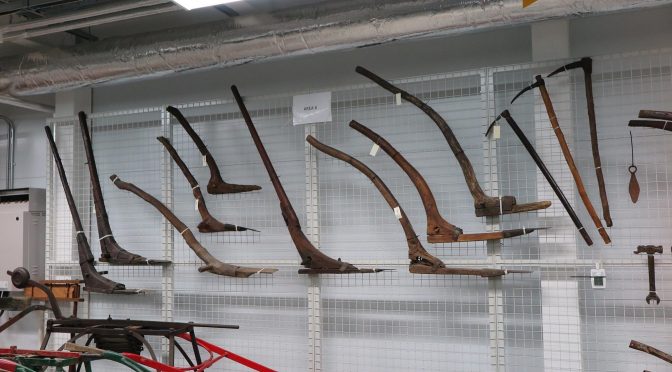The Board of Agriculture and Internal Improvement undertook an important survey of agriculture and rural improvement in Britain from 1793 to 1817. Each survey generally focused on a county or a small number of counties.
The accounts contained detailed accounts of the implements and machines used in each county, together with the changes that were being made to them.
The account for Inverness-shire written by David Souter, provides insights into the character and state of implements used in that county.
David Souter’s account is worth quoting at length:
“Owing to an attachment to old habits, and still more to the poverty of many of the smaller tenants, the implements of husbandry among this class are still of a very imperfect construction. These, however, are fast wearing out; and carts, ploughs, harrows, and other implements are now to be met with in every quarter of the district, of the most approved kinds, wither imported from Leith, or made by artisans in the county, many of whom are fully qualified for all branches of work necessary for agriculture.
Thrashing mills
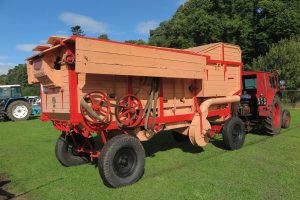 Mr Meikle’s highly approved thrashing mills are introduced on most of the large farms, and even on some of those of the middle size. There are wrought by two, but more generally by four horses, and sometimes by two or four oxen. Within the limits of this survey there are two wrought by wind. Water is always preferred, and often conducted from a considerable distance, at no small expense. These machines, in general, do the work in satisfactory manner, at the rate of from two to eight bolls an hour. Within the district there is one lately erected wrought by water, and capable of threshing from twelve to sixteen bolls an hour; the grain, at the same time, passing through two sets of fawners, is completely dressed for the market. Besides the great advantage of saving labour, the grain is more perfectly expelled from the straw than is generally done by the flail, and the fodder also being more bruised, is much more agreeable to the cattle. The cost of these machines is various, being in proportion to their respective powers. The general expense may be stated at from £30 to £60. Ins one cases, particularly where the fanners are appended for cleaning the corn, the expense is considerably higher.
Mr Meikle’s highly approved thrashing mills are introduced on most of the large farms, and even on some of those of the middle size. There are wrought by two, but more generally by four horses, and sometimes by two or four oxen. Within the limits of this survey there are two wrought by wind. Water is always preferred, and often conducted from a considerable distance, at no small expense. These machines, in general, do the work in satisfactory manner, at the rate of from two to eight bolls an hour. Within the district there is one lately erected wrought by water, and capable of threshing from twelve to sixteen bolls an hour; the grain, at the same time, passing through two sets of fawners, is completely dressed for the market. Besides the great advantage of saving labour, the grain is more perfectly expelled from the straw than is generally done by the flail, and the fodder also being more bruised, is much more agreeable to the cattle. The cost of these machines is various, being in proportion to their respective powers. The general expense may be stated at from £30 to £60. Ins one cases, particularly where the fanners are appended for cleaning the corn, the expense is considerably higher.
Plough
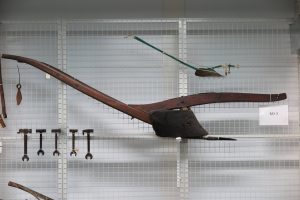 Except for breaking up moor and rough ground, the old Scots plough has been laid aside, and was first succeeded by that known by the name of the Rotherham plough, which is still in use, and is well adapted for making excellent work; but those invented by Small and others also do the work in a very superior stile, and, by their construction, are of a draught easier for the horses. The mould boards are, in general, of cast metal, imported frm the different foundries of Leith, &c though frequently the wooden mould board is still used. The price is from £3 to £4.
Except for breaking up moor and rough ground, the old Scots plough has been laid aside, and was first succeeded by that known by the name of the Rotherham plough, which is still in use, and is well adapted for making excellent work; but those invented by Small and others also do the work in a very superior stile, and, by their construction, are of a draught easier for the horses. The mould boards are, in general, of cast metal, imported frm the different foundries of Leith, &c though frequently the wooden mould board is still used. The price is from £3 to £4.
Drill plough, or horse hoe
This implement is to be met with on many farms of the district, differing little from the construction of the best forms of the common plough, except in the slenderness of its make, and the narrowness of its heel, so as to make a shallow furrow, and of small breadth. On the larger farms, the best construction of the horse or, with the double mould board, used in the southern districts for hoeing drilled turnips, potatoes, and beans, is also introduced.
Brake harrow
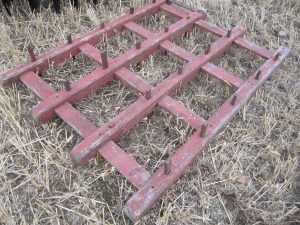 The brake harrow is of various sizes, generally requiring two horses, and sometimes four. It is principally used in harrowing rough ground, on new improvements, and frequently on the cultivated fields, when over-run with couch grass and other weeds. On some farms it is common to give the soil intended for turnip two [ploughings in the autumn; the first in the direction of the ridges, and the other across, without any harrowing. In this rough state the ground is left to pulverise by the winter frosts; in the spring the brake harrow is applied; and by those who adopt this practice, the effects are such in reducing the soil, that it is considered as fully equal to two ploughings. They are always made of ash wood, and cost from £3 o £6, according to the weight of the iron.
The brake harrow is of various sizes, generally requiring two horses, and sometimes four. It is principally used in harrowing rough ground, on new improvements, and frequently on the cultivated fields, when over-run with couch grass and other weeds. On some farms it is common to give the soil intended for turnip two [ploughings in the autumn; the first in the direction of the ridges, and the other across, without any harrowing. In this rough state the ground is left to pulverise by the winter frosts; in the spring the brake harrow is applied; and by those who adopt this practice, the effects are such in reducing the soil, that it is considered as fully equal to two ploughings. They are always made of ash wood, and cost from £3 o £6, according to the weight of the iron.
The common harrow is of different sizes, in proportion to the strength of the horses. On the small farms they are generally about four feet long, and three and a half feet broad, made of birch, alder, or fir, with sixteen iron teeth, each about around in weight, and cost from seven shillings to ten shillings. Upon the larger farms, the most common size is five feet in length, and four and a half feet in breadth, with twenty-four teeth, of at least one point weight each, made of well seasoned ash, of good workmanship, and cost £1 1s each.
Roller
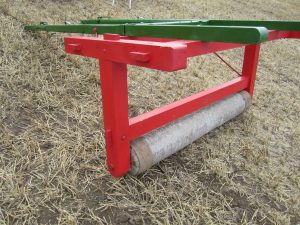 The roller is generally of granite, or what is called “peasy whin”, from four to five and half feet long, and from eight to fourteen inches in diameter. It is drawn by shafts similar to those of a cart and, in some cases, when four necessary, a box is fixed above the roller, filled with small stones, for increasing the weight. It is wrought generally by one, sometimes by two horses. Since the introduction of cutting the corns with the scythe, almost every farmer has one; and all the fields, after the crop is sown and harrowed, are now rolled, for the purpose of smoothing the surface against harvest. It is used, besides, for harrowing the grass lands, for breaking the clods, and pulverising the soil, before as well as after sowing the wheat, barley, and turnip fields. In this county it is considered as a very useful and necessary implement of husbandry-the price from £1 10s to £3.
The roller is generally of granite, or what is called “peasy whin”, from four to five and half feet long, and from eight to fourteen inches in diameter. It is drawn by shafts similar to those of a cart and, in some cases, when four necessary, a box is fixed above the roller, filled with small stones, for increasing the weight. It is wrought generally by one, sometimes by two horses. Since the introduction of cutting the corns with the scythe, almost every farmer has one; and all the fields, after the crop is sown and harrowed, are now rolled, for the purpose of smoothing the surface against harvest. It is used, besides, for harrowing the grass lands, for breaking the clods, and pulverising the soil, before as well as after sowing the wheat, barley, and turnip fields. In this county it is considered as a very useful and necessary implement of husbandry-the price from £1 10s to £3.
Carts
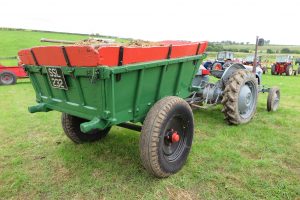 In the former wretched state of the roads in this district, double carts, that is, a shaft and trace horse to one cart, were almost uniformly employed. The work is now, in most cases, performed by single horse carts, of which two take in a greater weight of grain, lime, or dung, &c than the double cart used to do, with more ease to the horses, and much less tear and wear to the carriages.
In the former wretched state of the roads in this district, double carts, that is, a shaft and trace horse to one cart, were almost uniformly employed. The work is now, in most cases, performed by single horse carts, of which two take in a greater weight of grain, lime, or dung, &c than the double cart used to do, with more ease to the horses, and much less tear and wear to the carriages.
Carts are now much improved in their construction, the length of the body being about five feet, and the breath three and a half feet. The axletree is, in general, of iron, and the wheels from four to four and a half feet in diameter. The price from £12 to £14.
Turnip drill
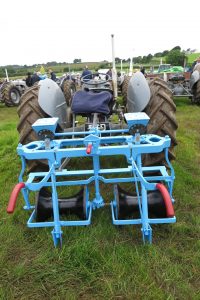 On the introduction of the drill cultivation of turnip, the seed was dropped from the hand, and in some cases pretty equally divided, while in others, more than triple the necessary quantity of seed was given. Machines for this purpose became, however, in short time, very common. The turnip drill, in general use on the smaller farms, is a very simple machine, and costs about £1 6s. It has a wooden wheel in front, of a simple make, somewhat sillier to that of a common dung barrow, to which is affixed a small rope for turning the cylinder in which the seed is deposited, and drop through a tube into the middle of the drill.
On the introduction of the drill cultivation of turnip, the seed was dropped from the hand, and in some cases pretty equally divided, while in others, more than triple the necessary quantity of seed was given. Machines for this purpose became, however, in short time, very common. The turnip drill, in general use on the smaller farms, is a very simple machine, and costs about £1 6s. It has a wooden wheel in front, of a simple make, somewhat sillier to that of a common dung barrow, to which is affixed a small rope for turning the cylinder in which the seed is deposited, and drop through a tube into the middle of the drill.
What is called Knight’s drill, which sows two rows at a time, and is made in this district, at a price of eight guineas, is now used on a few of the large farms.
Before Knight’s barrow was known here, a farmer of this district invented one for his own use, which, if it does not exceed, at least equals, any other implement of the kind as yet heard of in this quarter. It is drawn by one horse, and sows, harrows, ad rolls, two drills at a time, in the neatest manner I have ever seen. I am not at liberty to give the name of the inventor.
Horse hoeon a new construction
The same farmer has also invented a horse hoe on an improved construction, which, in all its operations, is the most effective implement of the kind I have ever seen.
The photographs of the selection of implements was taken at the Strathnairn Vintage Rally, September 2014 and other locations.
